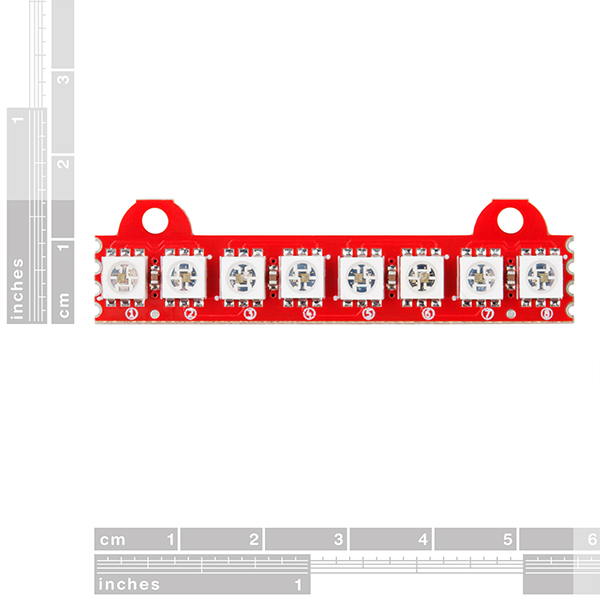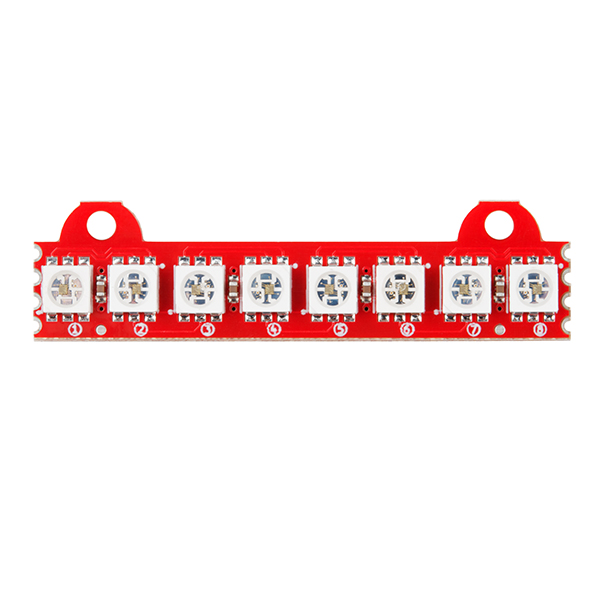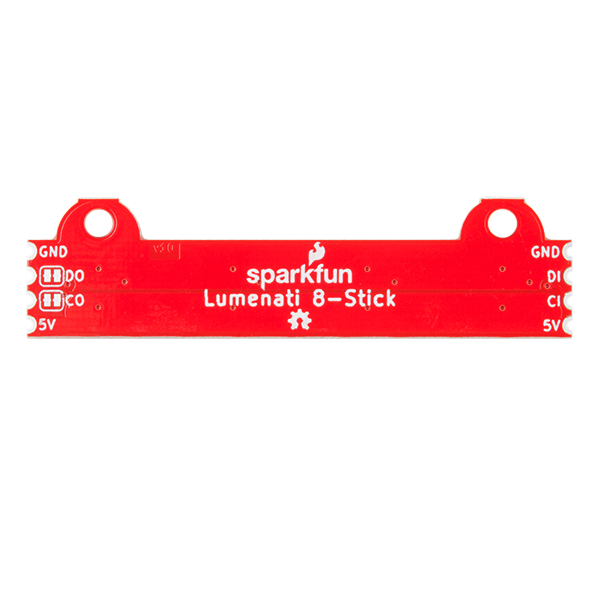SparkFun Lumenati 8-stick
The SparkFun Lumenati 8-stick is a small board equipped with eight APA102C LEDs in a row and two mounting positions, that has been designed to give your projects an edge in their lighting capacity. The 8-stick board has been specifically designed to be daisy-chained with other Lumenati boards, thanks to the castellated edge connectors at each end allowing for multiple design options and formations. Additionally, we have labeled the APA102C LEDs on each board with numbers indicating their position in the sequence to help you write code more easily. We especially love using the Lumenati boards to give our flying race drones a bit of style and panache.
The Lumenati 8-stick can also be combined with the 90R and 90L boards to create outlines of different shapes and sizes.
The APA102C addressable LEDs operate on +5V power input, as well as 0--5V logic levels for clock and data, and employ a 2-wire communication protocol consisting of a clock line and a data line. While this requires one more wire than standard WS2812B LEDs, the advantage is that the communication with the LEDs becomes somewhat timing-independent, allowing you to run these directly off of a Raspberry Pi or other single-board computer that doesn’t normally allow for a long, precisely timed data stream without the use of additional hardware.
Note: There are two solder jumpers on the back of the 8-stick labeled CO and DO (clock out and data out) that can be cut to interrupt those signals in case you make a closed-loop design where you don’t want the clock and data from your last LED to interfere with the clock and data to your first. It is critical that you cut the traces in the jumpers of the last board in the loop before you power up your LEDs if you’ve put together a continuous loop of Lumenati boards. Otherwise, it is likely that you’ll burn out a couple of LEDs.
- Dimensions: 56.6mm x 15mm x 3.2mm (2.22" x 0.6" x 0.12")
- Weight: 2.8g
SparkFun Lumenati 8-stick Product Help and Resources
How to Solder: Castellated Mounting Holes
May 12, 2015
Tutorial showing how to solder castellated holes (or castellations). This might come in handy if you need to solder a module or PCB to another PCB. These castellations are becoming popular with integrated WiFi and Bluetooth modules.
Lumenati Alien Garden
November 3, 2017
Use Lumenati LED boards to add glow to your own alien garden.
Lumenati Hookup Guide
October 12, 2017
Lumenati is our line of APA102c-based addressable LED boards. We'll show you how to bring the sparkle to your projects!
APA102 Addressable LED Hookup Guide
October 8, 2019
Connect, power, and control your APA102 addressable LED strip!
Core Skill: Soldering
This skill defines how difficult the soldering is on a particular product. It might be a couple simple solder joints, or require special reflow tools.
Skill Level: Competent - You will encounter surface mount components and basic SMD soldering techniques are required.
See all skill levels
Core Skill: Programming
If a board needs code or communicates somehow, you're going to need to know how to program or interface with it. The programming skill is all about communication and code.
Skill Level: Rookie - You will need a better fundamental understand of what code is, and how it works. You will be using beginner-level software and development tools like Arduino. You will be dealing directly with code, but numerous examples and libraries are available. Sensors or shields will communicate with serial or TTL.
See all skill levels
Core Skill: Electrical Prototyping
If it requires power, you need to know how much, what all the pins do, and how to hook it up. You may need to reference datasheets, schematics, and know the ins and outs of electronics.
Skill Level: Rookie - You may be required to know a bit more about the component, such as orientation, or how to hook it up, in addition to power requirements. You will need to understand polarized components.
See all skill levels
Comments
Looking for answers to technical questions?
We welcome your comments and suggestions below. However, if you are looking for solutions to technical questions please see our Technical Assistance page.
Customer Reviews
3 out of 5
Based on 3 ratings:
Easy handling but quality issues
So i ordered 10 of these for a small project, while the first one I tried had a defect with a capacitor after the 5th LED. I tried resoldering the capacitor but that did not really work out. After that i took a closer look under the microscope where i saw a couple of soldering issues with some of the other sticks as well.
Nevertheless, playing with these is super easy and a ton of fun.
all 3 sticks had LED's 6, 7, 8 non operational
Recently I purchased a second batch of 3 sticks and all had LED's 6, 7, 8 non operational. I tested these against an older batch of 3 sticks I had purchased in the past, and all three of those work fine.
Sorry to hear you're having trouble! Please contact our technical support department and we can get those fixed for you.
Worked as promised
Piece of cake to set up over SPI on Arduino!





Assuming an adequate supply, how many of these could one chain together before addressing or current becomes a problem? Is it possible to multi-tap the 5v to reduce board-board current?
Looking to run a long line, about 7 feet (maybe 18 of these 8-strips), of these. The 2-wire/Pi compatibility and 5v make this much preferable to commonly available 1-wire 12v LED strips.
Note to self: Learn to RTFM
2000 pixel max, so 250 of these boards ~ 120 feet. Addressing won't be a problem.
Multi-tapping is possible, and even recommended (based on COM-14016 datasheet) for long runs.
5V 70A supply is good for 1200 pixels, so 18 * 8 = 144 pixels. Using a 5V 20A supply should be no problem.
Nice to see some APA102 products as alternatives to WS2813.
I like my WS2813 leds, but they can be annoying to control by anything but microcontrollers and are kind of slow (the more leds the lower the amount of updates per seconds you can push through). APA102 are a nice alternative to them.
What really helps is that they are supported by the fastled library. So any project that uses Fastled for controlling can be converted to use APAs with just a few lines of code.